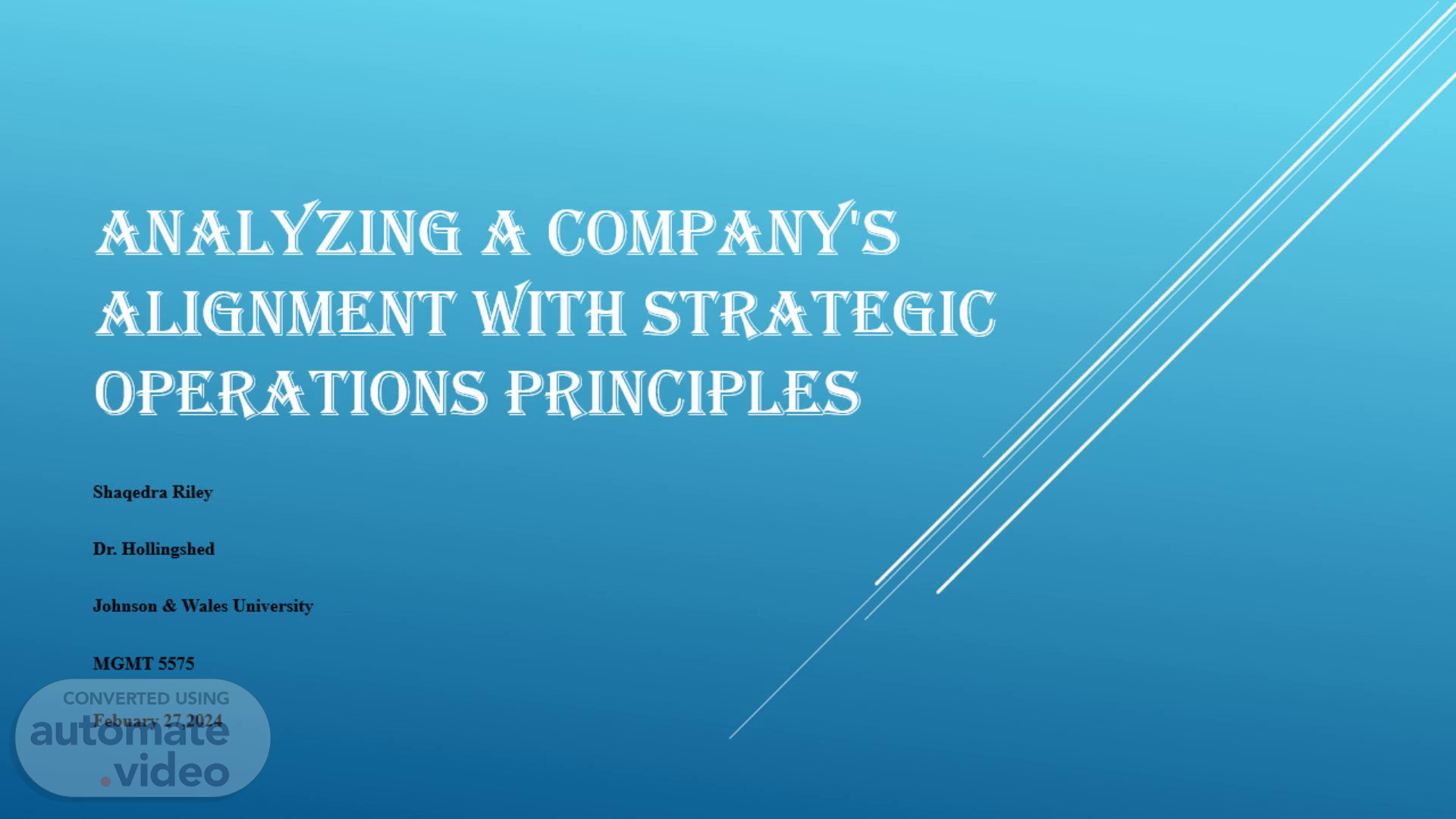
Page 1 (0s)
Analyzing a Company's Alignment with Strategic Operations Principles.
Page 2 (9s)
[Audio] A company's success depends on strategic operations management in today's fast-paced, competitive business climate. Production, quality control, supply chain, inventories, and scheduling must be managed well. This presentation will assess a fictional company's alignment with quality, process and capacity planning, supply chain management, inventory management, and scheduling. For each concept, the company's present practice and cost-cutting and improvement suggestions will be reviewed. We want to find ways to enhance operations management and showcase best practices that boost efficiency, cost savings, and customer happiness..
Page 3 (51s)
[Audio] The firm controls quality via manual inspections and inadequate data analysis. This approach is slow, error-prone, and lacks real-time monitoring, which might reduce efficiency and quality. Lean manufacturing methods like root cause analysis and mistake-proofing might save expenses for the organization. These methods may discover and remove fault sources, minimize waste, and boost manufacturing efficiency. The organization could also consider Six Sigma or Total Quality Management to improve their quality management. These systems foster continuous improvement, customer satisfaction, and data-driven quality management, allowing the organization to continuously produce high-quality goods and services..
Page 4 (1m 39s)
[Audio] The firm manufactures using work shop and batch procedures. This flexible strategy might lead to inefficiencies and overproduction. Capacity planning also uses past demand trends, which may not represent market circumstances. The firm should analyze process flows and find productivity bottlenecks to save expenses. Waste may be reduced and throughput enhanced by optimizing resource allocation and eliminating bottlenecks. Additionally, the organization can use lean or flexible manufacturing technologies to improve their process and capacity strategy. These tactics may improve customer service and reduce capacity by making the organization more flexible to variable demand..
Page 5 (2m 24s)
[Audio] Partners have little visibility and engagement in the company's fragmented supply chain management. Poor communication and segregated operations may cause inefficiencies, coordination issues, and higher expenses. Technology like supply chain management software might save expenses for the organization. These solutions help simplify operations, increase partner communication and data exchange, and save human administrative costs. The organization should also create a collaborative supply chain strategy that promotes information exchange, risk reduction, and joint optimization with key suppliers and customers to improve supply chain management. Collaboration improves responsiveness, creates value for supply chain partners, and gives a market edge..
Page 6 (3m 18s)
[Audio] The corporation tracks and orders inventory using manual and minimal software. This technique typically leads to excess inventory, locking up capital and increasing storage and maintenance expenses. Consider vendor-managed inventory (VMI) and kanban systems for just-in-time (JIT) inventory management to save expenses. These methods may decrease carrying costs, cash flow, and waste by optimizing inventory levels. The organization should also use demand forecasts and safety stock calculations to improve inventory management. These approaches may balance inventory levels with customer service, ensuring the firm has enough goods to fulfill demand without overstocking..
Page 7 (4m 7s)
[Audio] Gantt charts and manual resource allocation are used to manage production schedules and resource usage at the organization. It takes time, is error-prone, and typically leads to inefficiencies, delays, and poor resource allocation. The organization should use scheduling software or optimization techniques to save expenses. Minimizing idle time, improving job distribution, and decreasing labor expenses from poor scheduling may increase resource use. In addition, the organization should use sophisticated scheduling methods like TOC or lean scheduling to improve their scheduling. These strategies detect and manage production bottlenecks to improve flow and productivity. These methods help the organization simplify processes, cut lead times, and satisfy client demand. Gantt charts and manual resource allocation are used to manage production schedules and resource usage at the organization. It takes time, is error-prone, and typically leads to inefficiencies, delays, and poor resource allocation. The organization should use scheduling software or optimization techniques to save expenses. Minimizing idle time, improving job distribution, and decreasing labor expenses from poor scheduling may increase resource use. In addition, the organization should use sophisticated scheduling methods like TOC or lean scheduling to improve their scheduling. These strategies detect and manage production bottlenecks to improve flow and productivity. These methods help the organization simplify processes, cut lead times, and satisfy client demand..
Page 8 (5m 54s)
references. Baker, K. R., & Trietsch, D. (2019). Principles of sequencing and scheduling. John Wiley & Sons. Chopra, S., & Meindl, P. (2016). Supply chain management: Strategy, planning, and operation (6th ed.). Pearson. Heizer, J., Render, B., & Munson, C. (2017). Operations management: Sustainability and supply chain management (12th ed.). Pearson. Jacobs, F. R., & Chase, R. B. (2018). Operations and supply chain management (15th ed.). McGraw-Hill Education. Muller, M. (2019). Essentials of inventory management (3rd ed.). AMACOM. Reid, R. D., & Sanders, N. R. (2019). Operations management: An integrated approach (7th ed.). Wiley..